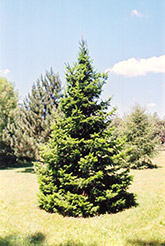Height: 40 feet
Spread: 20 feet
Sunlight:
![]()
![]()
Hardiness Zone: 2
Description:
An extremely hardy yet delicate spire-shaped evergreen, excellent for articulation in the landscape; quite tough, but needs rich soil and protection from drying winds, not for every landscape
Ornamental Features
Siberian Fir is primarily valued in the landscape for its distinctively pyramidal habit of growth. It has dark green evergreen foliage. The needles remain dark green throughout the winter.
Landscape Attributes
Siberian Fir is a dense evergreen tree with a strong central leader and a distinctive and refined pyramidal form. Its average texture blends into the landscape, but can be balanced by one or two finer or coarser trees or shrubs for an effective composition.
This is a relatively low maintenance tree, and usually looks its best without pruning, although it will tolerate pruning. It has no significant negative characteristics.
Siberian Fir is recommended for the following landscape applications;
- Vertical Accent
Planting & Growing
Siberian Fir will grow to be about 40 feet tall at maturity, with a spread of 20 feet. It has a low canopy, and should not be planted underneath power lines. It grows at a slow rate, and under ideal conditions can be expected to live for 60 years or more.
This tree does best in full sun to partial shade. It prefers to grow in moist to wet soil, and will even tolerate some standing water. It is not particular as to soil pH, but grows best in sandy soils. It is quite intolerant of urban pollution, therefore inner city or urban streetside plantings are best avoided, and will benefit from being planted in a relatively sheltered location. Consider applying a thick mulch around the root zone in winter to protect it in exposed locations or colder microclimates. This species is not originally from North America.
